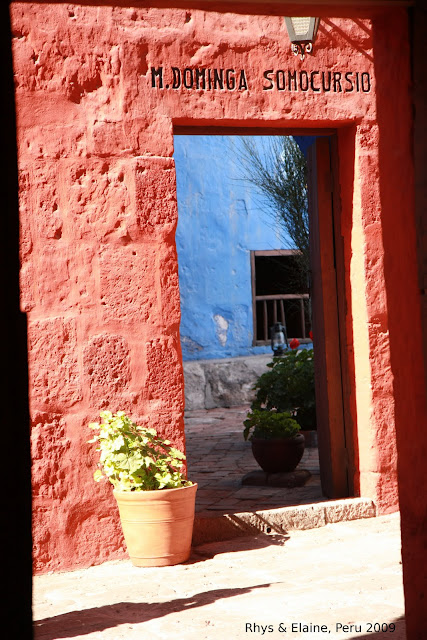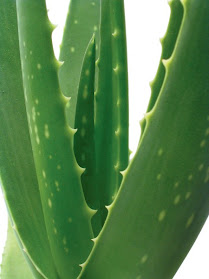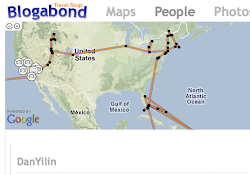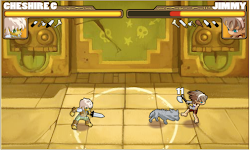They have just returned to Singapore, and have graced us with an interview. Man, we love interviews! :p Their interview is split into 3 sections, Places, People and Pleasures. We'll have Places today, and combine People and Pleasures for your reading pleasure tomorrow! Oh, one more thing. Because I think our regular readers have now started to associate green with the male voice and purple with the female voice, we are letting them use our actual colors for this interview!
----------------------------------------------
Places
Q: Much as we would like to think otherwise, we (unfortunately) are not the main draw in our friends' decisions to visit South America. So what made you decide to travel to Peru?
E: We had both (separately as well as together) travelled to the States and most of West and East Europe, and S. America was a continent we haven't yet covered entirely. We also loved our experience in Central and S. America before and were keen to see more of it. We also like the great outdoors and nature more than cities, and felt that Peru would have a good mix of trekking, culture and pretty scenery. And of course, the Inca Trail was the main reason for our trip.
R: It was between Peru (for Machu Picchu) and Kilimanjaro. In the end I voted in favour of Machu Picchu because the highest we would climb to on the Inca Trail (Dead Woman's Pass) was 4200m compared to Kilimanjaro - a whopping 5895m high! I had heard so much about altitude sickness and was not keen to have my hard earned vacation marred by headaches and nausea so Peru it was!
Q: You had about 2 weeks to spend in Peru. What was your itinerary like? Why did you choose to visit these places in particular?
E: We had about 17 days. A significant part of the trip was the 2 treks we did - the 4D Inca Trail and the 3D Colca Canyon Trek. Since we needed to secure permits for the Inca Trail, the dates for everything else basically had to be arranged around it.
We flew into Lima, then spent a full day in Trujillo, followed by a day in Arequipa which was the gateway city to the Colca Canyon Trek. Thereafter, we visited Puno/Lake Titicaca before moving on the Cuzco for the Inca Trail, and ended off with a visit to Paracas and the Nazca + Palpa lines.
One reason for deciding on the route Arequipa--Puno--Cuzco was the progressive increase in altitude - to help us acclimatise for the Inca Trail. Arequipa was the lowest point at 2300masl where we we proceeded to the Colca Canyon for a trek at 3600masl. We then travelled to Puno/Lake Titicaca which is about 3900masl for a couple of days where we had a relatively relaxed programme. We finally moved on to Cuzco (which is lower than Puno at 3300masl) to get ready for the Inca Trail, which reaches a maximum altitude of 4200masl.
Trujillo, we picked for the pre-Inca ruins which showcased the Chimu and Moche cultures - Peru isn't really just about the Incas. Afterall, the Incas had a really short reign in the bigger scheme of things. The Chimu culture dated from AD 850 - 1500 and they built Chan Chan, the largest adobe city in the world, covering 28 sq km. The Moches (200BC - AD850) built the Huacas del Sol y de la Luna containing beautiful friezes on 6 levels, one for each generation, built on top of each other in the shape of an inverted pyramid.
Trujillo was also close to a tiny fishing village, Huanchaco, where the fishermen still row out to see in their little reed "sampans".
Arequipa, Peru's 2nd largest city, is also known as the White City, after the dazzling white volcanic rock (sillar) with which many of the city's grand colonia buildings were built. The city is surrounded by volcanos, the nearest being El Misti and Chachani.
 El Misti
El MistiWe paid a visit to Juanita, the ice princess, a frozen Inca girl sacrificed on the summit of Apu Ampato and explored the Monasterio de Santa Catalina, a maze-like convent occupying a whole block and surrounded by high walls - a 20,000 sq metre complex akin to a citadel within the city.
 Hallways - Monasterio de Santa Catalina
Hallways - Monasterio de Santa CatalinaColca Canyon was because it was the 2nd deepest gorge in the world and we thought it would be a nice warmup to the Inca Trail, but we were so wrong - we felt the Colca Canyon was tougher at some points and the aftermath made us wonder (at that time) if completing the Inca Trail was even possible, because we were hurting so much from the trek.

Colca Valley
Lake Titicaca is the highest navigable lake (not sure what that means - isn't any lake where you plonk a boat navigable?) and it looked really pretty from what pictures we saw of it. It was also conveniently kind of on the way to Cusco.

We went to Cusco, explored the Sacred Valley and went on the Inca Trail for obvious reasons - to see Machu Picchu, the most famous landmark in Peru, the lost city of the Incas.
And finally, Nazca to see the mystical lines of Nazca and Palpa, and along the way stopped at the Paracas reserve (a large desolate desert reserve, part of the Atacama) and Huacachina oasis.
R: This is more a question for E as she did all the planning! I was consulted of course but really just rubber stamped her decisions. Most of the time when she had trouble deciding between hotels/routes/attractions and consulted me (often late at night), I was really trying to guess what she preferred rather than make any choices of my own because I knew that if I guessed wrongly, it was going to be a long night!
But don't get me wrong, I'm more than happy to defer to her when it comes to trip-planning because she's great at it!
Q: There are so many different aspects to Peru to love: archaeological sites, mountain ranges, colonial cities, indigenous communities and cultures, and just stunning natural scenery all around.
Which of the places you visited appealed to you the most, and why?
E: We are drawn more to natural scenery - the mountains, the huge expanses of land, the outdoor activity and trekking. The local culture and indigenous people also made for a colourful experience with great photo opportunities.
We are continually awed by the archaelogical sites, especially since it was all achieved in primitive times where there was no machinery or modern technology, but I think we are largely outdoor-scenery-activity people, and without a doubt, the Inca Trail was our favourite part of the trip. Trekking through the magical cloud forests, we got amazing vistas of the flora and of the various Inca ruins that you can't see from the train to Aguas Calientes, some of the campsites we stayed at were really pretty, with waterfalls, streams and snow-capped mountains in the distance, and the sheer effort taken to climb over all 3 high altitude passes made the experience even more memorable. Although we made the trek in a bid to reach Machu Picchu the trek itself was as much a highlight as the ultimate goal itself.
R: Totally agree with E that we are mountains, rivers, natural landscape kind of people rather than museums and cities or even archaeological sites (unless they are extremely well preserved).
From experience, we tend not to do nor want to do anything much in cities during our vacations other than dining and shopping and this trip was no different. We just find it very hard to drag ourselves all over the city, trudging through museums, and taking precautions over petty crimes that plague many cities in third world countries.
But put us in a picturesque landscape away from bustling cities and you won't find a more enthusiastic pair! Therefore it was no surprise that by far the most amazing, enjoyable and memorable part of the trip was the 4D 4N Inca trek that we did. The scenery of course was beautiful and at times even surreal (eg. walking through clouds?!) and while Machu Picchu was nothing short of amazing, I was surprised to find myself thinking that I would do the trek even if there wasn't the prize of Machu Picchu at the end of the journey.
The fact that most members of our trekking group were really decent people and that we really enjoyed their company also added to the beauty of the experience.
Q: Do you have any recommendations for a good night's stay in the places you visited?
Lima - Hotel Senorial in Miraflores, $72/night: a very clean and comfortable place with good hot showers, and conveniently located only a few blocks away from Larcomar. Beds were firm and most of the pillows were good (i.e. not lumpy).
Trujillo - Hotel El Paraiso, $60/night: centrally located 3 blocks from the Plaza de Armas, clean and good hot showers, but there was some random noise even though we were in a room away from the main street.
Arequipa - Sonesta Posada del Inca, $108/night: right on the Plaza de Armas, clean and comfortable, excellent location, breakfast is served on a terrace with great views of the cathedral adn the main square. Coca tea is provided in the lobby to combat any altitude sickness.
Puno - Sonesta Posada del Inca, $108/night: this is about 5 km (about 7 mins taxi ride)
from the city centre, it is peaceful and has gorgeous views of Lake Titicaca. A good breakfast spread and I think it's the "poshest" of all the hotels we stayed on during this trip. Excellent hot showers (which was very important, as this was our first shower in 2 days, straight after the Colca Canyon trek (due to transport schedules) and we were really dirty, crusty and grimy), superbly comfortable beds and fluffy pillows. It also had the prettiest bathroom with all amenities.
Cuzco - Hotel Rumi Punku in San Blas, $90/night: located in the artsy San Blas neighbourhood, on a street just between Plaza San Blas and Plaza de Armas. A quick, comfortable walk down to the main square, but you might get a little breathless walking back up if you're not acclimatised. It has a real Inca doorway (Rumi Punku means "stone door") which leads into a pretty courtyard. Rooms were spacious, beds were comfortable and again hot showers with good pressure (we can't over-emphasis this because in Peru, you don't always get a sufficiently pressurised water source that's hot enough!).
Nazca - Hotel Casa Andina, this was booked by the agency that organised the Nazca flight for us: conveniently located 1 block from the main square, clean and very spacious with firm beds and good pillows. First place that had an air-conditioner too!]
Q: We have to congratulate you on completing the 4-day trek along the Inca Trail to Machu Picchu! We heard that the highest point of the trek was this scary-sounding place called Dead Woman's Pass at 4,215m above sea level. Describe how you felt before you made it up Dead Woman's Pass.
Do you think you were sufficiently prepared (in all aspects - physically, mentally and equipment-wise) to trek the Inca Trail?
R: Before commencing on the Inca trek, we had heard many stories about how tough it was, the mozzies, the rain, the altitude sickness (reading about Yilin's bad experience on her Huaraz trek certainly didn't help!), the camping and not bathing... I must admit that I was more than a little apprehensive. At the start of the trek when we saw the Machu Picchu bound trains chugging past us, I was extremely envious and wondered whether the trek was going to be worth it.
That feeling didn't last long and soon I was revelling in the entire trekking experience!

Km 88: Start of the Inca Trail

1st Night - Wayllabamba campsite
The trek was certainly not a walk in the park. It was replete with steep and dangerous ascents and descents - ascents are terrible on your lungs, heart and leg muscles while descents are terrible for your knees so it was hard to decide which I preferred.
At certain points of the trek, all you see are giant rocky steps before you and all you can do is cling on to the lifeline that your guide had given you - XX hrs to the next rest stop.
The toughest part of the trek was definitely the second day - the ascent to the infamous Dead Woman's Pass. The ominous sounding pass is really so named because from a distance, it looks like a woman (from waist up) lying on her back. It took us about 5.5hrs (with a rest stop) to conquer this darn pass, followed by a 3+ hour steep descend to our camp for the night.
The first part of the trek was extremely demoralising because it was a long hard ascent through forested area and you don't really have a view of anything except the huge rocks before you and equally tired faces of other trekkers. Each time I ascended a section of the trail, a little glimmer of hope that maybe there would be a nice flat stretch coming up next would arise.
The glimmer of hope would be mercilessly crushed every single time.
After the rest stop, we ascended a little while more before we caught our first glimpse of Dead Woman's Pass. While this stretch of the trail was no easier than the first, the pain was much alleviated by the spectacular panoramic views of the mountain peaks and valleys. The fact that we could affix our eyes on our target, Dead Woman's Pass, for most of this part of the trek also gave us motivation and an extra spring in our steps.
When we reached the pass after 5.5hrs of excruciating pain, the euphoria was like nothing I had experienced before.

Moment of Conquest
I think that a minimum level of fitness is required for the Inca trek. E and I did try to go for some runs before the trip but I think we managed about 5 runs in all due to our busy work schedules. We were obviously not in peak condition, but were not extremely unfit either. While we could have been better prepared physically, I think we acquitted ourselves well enough. On the way up to Dead Woman's Pass, one fellow trekker even gave E an unsolicited compliment, calling her a tough cookie!
We were extremely blessed not to have any altitude sickness or physical discomfort during the trek. Our prayers for beautiful weather were also answered and this not only ensured that we had beautiful views throughout the trek but also meant that we didn't have to deal with physical discomfort that comes with rain, mud and cold.
Equipment-wise, we found the cheap (4 soles!) wooden staff we bought just before the Inca trek invaluable in providing extra support during the trek. For me, it made the descents so much easier and less treacherous as the rocks were huge and you would frequently have to go on all fours if you didn't have the help of the wooden staff. No need for any expensive steel walking sticks, the cheap wooden staff worked just fine.
We also brought along wool socks and heat packs which came in very useful at night (when the temperatures went below 0 degree celsius). A clean set of clothes that you wear only at night to sleep is also extremely useful to combat camping fatigue and boost our morale.

Paqaymayu Campsite
For equipment, I'd also add that wet wipes were one of our little luxuries, as were our little blow-up pillows. And this doesn't really fall into the category "equipment", but the local snacks like bak kwa and dried squid that we brought along from home was really great for a little boost when hunger strikes and energy levels were low!
Q: If you were to plan this trip again, would you do anything differently?
Don't think we would do it much differently, given the time constraints we had. If possible we would want more time in Cuzco and Lake Titicaca. At Lake Titicaca, we would have liked to spend an extra day exploring islands further away, such as Amantani. For Cuzco, due to anticipated nationwide strikes, we had to leave a day earlier for the Inca Trail, and did not have time to explore the city. We would have loved to visit the cathedral, and spend more time resting after the Colca Canyon trek before starting on the Inca Trail, and just soaking in the atmosphere. And if time were really not a factor, we'd go to the Codillera Blancas too!





















































